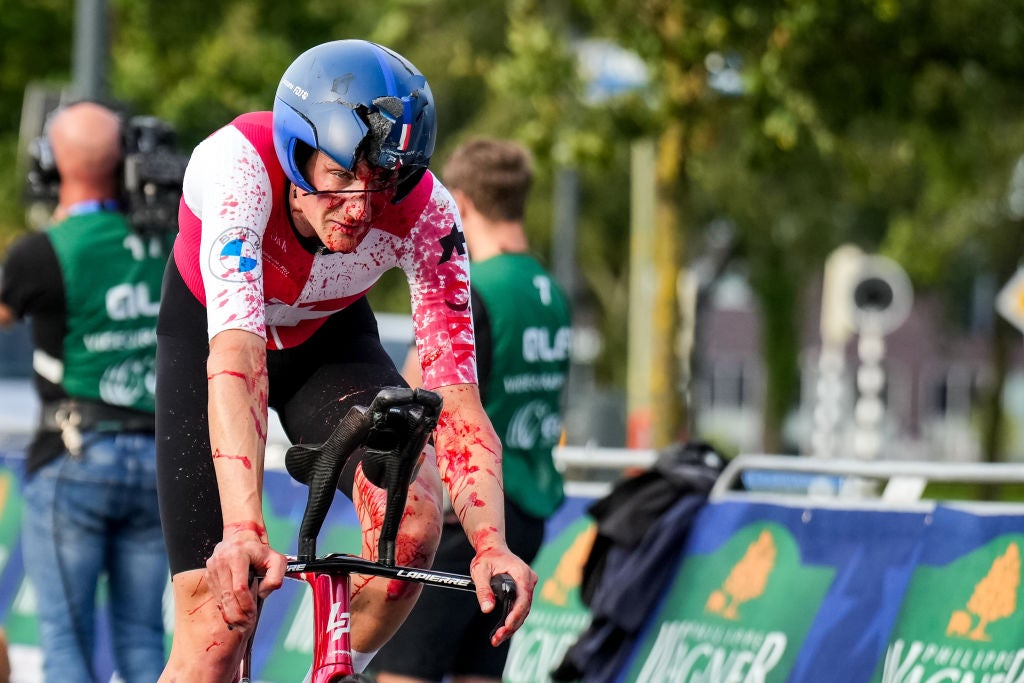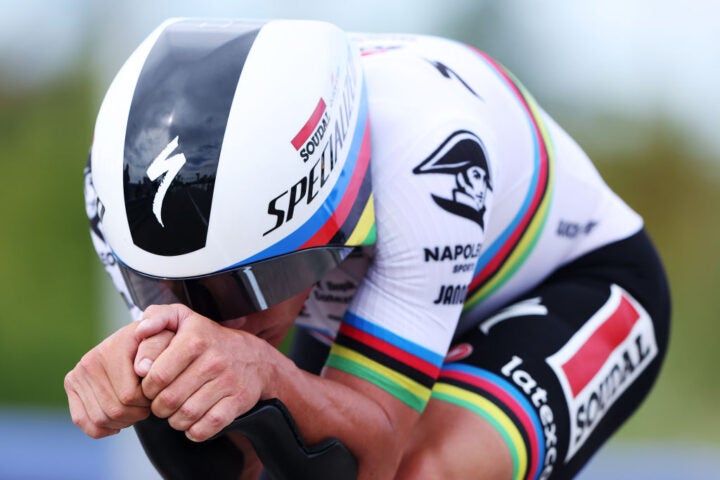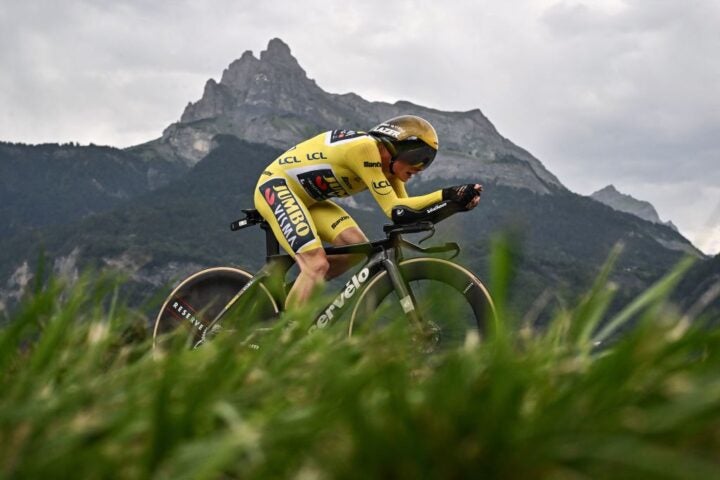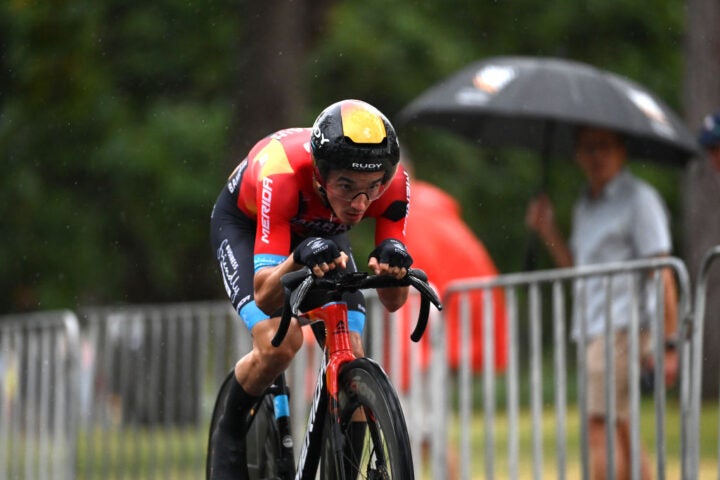
Artikel
09
januari
Does Pro Cycling Have a Time Trial Safety Problem?
Have the time trials of pro cycling gotten faster than the safety regulations that govern them?
Stefan Küng believes so. The Swiss speedster is calling for change so there needn’t be a compromise between safety and speed in a discipline dominated by extra-extreme aero positions that limit lines of sight.
“Race organizers or the UCI have to address the issue that we no longer do 50kph in time trials, but rather 55kph or 60,” he last week told Radsport-News.
“The ball is in the UCI’s court,” Küng said.
But what might the UCI do to prevent a repeat of the recent horror crash that left Küng covered in blood?
New rules introduced in 2023 backfired, and there’s no indication of the governing body making a fix before racing dawns on the 2024 calendar.
2023 regulations ‘made everything even more extreme’

Küng shot into the spotlight last season for all the reasons he didn’t want.
The strapping Swissman plowed headfirst into a set of barriers in the final kilometers of the European TT championships before he pedaled to the line, his time trial helmet in tatters and body covered in blood-splatters.
As he later told SRF, “I think it was a guiding problem. During a time trial I am basically blind.”
Also read:
“Aero is everything” in the world of elite-level time trialing.
You can have all the watts you want, but if your CdA (“coefficient of aerodynamic drag”) is out of whack, you’re pushing power without making progress.
With better understanding of aerodynamics, riders became more and more aggressive in their time trial positions – and particularly where they put their heads, the biggest wind-blocker on the bike.
The new normal “face-in-forearms” position is fast – an example of aero excellence.
But riders can’t see much more than their front tire when their face is pointed almost directly downward. They’re left to rely on radio communications from the team car to help navigate them through 50kph corners and pothole-riddled pavement in an adrenaline-fuelled game of risk.
When that process failed in the European championships last September, Küng came away with concussion, a fractured cheekbone and fingers, and a time trial helmet destined for the trash.
Oh no Stefan Küng hits the barriers and goes down. This is horrendous. The helmet! Good lord. pic.twitter.com/N8f4eFU1uo
— robyn (@robynjournalist) September 20, 2023
As one of the leading time trialists in the world, Küng has his skinsuit in the game in ensuring his discipline is safe.
“The UCI should address the issue. You can’t tell a rider that he just has to lift his head. Riders will always do what makes them fastest,” Küng told Radsport.
“Race organizers or the UCI have to address the issue that we no longer do 50kph in time trials, but rather 55kph or 60,” he continued.
“[Race organizers] might have to mark bends or such grids differently, perhaps with markings ahead of them on the street. The framework conditions must be created so the sport can take place safely at the level at which it now takes place.”
The UCI already attempted to fix some its time trialing problems.
At the start of last season, it introduced three rider height-categories to fix perceived benefits conferred to shorter “aero bullets” like Remco Evenepoel by the existing positional regulations.
Rulebook revisions for the start of 2023 gave each rider-category its own framework for the “depth” of time trial extensions, so allowing taller riders like 193cm “King Küng” the room to fine-tune their front-end.
The change was intended to level the playing field – but it came with some devastating unintended consequences.
Faces went closer to forearms, and a rider’s line of sight got smaller.
“The ball is in the UCI’s court,” Küng said. “They noticed that the position adjustments a few years ago gave smaller riders an advantage. They have now adjusted that, but that has made everything even more extreme.”
What could cycling chiefs do?

The UCI recently indicated to Cycling Weekly it would look again at its TT regulations.
The governing body previously imposed controversial sanctions for so-called “extreme” positions on road bikes like the “super tuck”, “puppy paws”, and bent-in brake hoods.
The UCI doesn’t seem to be so sure what to do about TTs however.
“In today’s quickly evolving search of performance optimization, particularly in aerodynamics, there is a clear risk of riders prioritizing performance at the cost of visibility and safety. Complementary to regulatory measures, more educational efforts are therefore needed to address this issue and to raise awareness among riders about the risks involved in adapting low head positions,” the governing body stated to Cycling Weekly.
“To enhance safety in professional road cycling, the UCI is collectively working with its stakeholders, including riders, teams and race organizers, addressing safety concerns and implementing effective measures to increase the safety and wellbeing of all participants in the sport.”
Road bike time trials, sanctions for poor safety, racing ‘lines’?

Top time trialists like Küng, Evenepoel, Filippo Ganna, and Wout van Aert will have spent the winter pedaling into wind tunnels in the bid to perfect their position for the 2024 WorldTour and Olympic season.
The opening “race against the clock” of the WorldTour calendar is expected to come at the UAE Tour in February.
Further down the line, the season’s three grand tours feature a total six ITTs, including a high-stakes dash around the hills of Nice in the final stage of the Tour de France.
Will the UCI have made time trials look altogether different by that time?
Should teams throw away their time trial machines and race on road bikes? Could punishments be imposed on riders that fail to look forward? Or maybe marshals will be painting “racing lines” onto race courses in 2024?
At present Rolls Royce rouleurs like Küng are forced to find their own tipping point between safety and speed.
No matter what the UCI does, the two will remain in tricky time trial tension when aero truly is everything.
What's your reaction ?
Follow us on Social Media
Recent posts

July 27, 2024
Nieuwe kabinetsvisie: samen sterker tegen cyberdreigingen

July 24, 2024
Navigating AI Implementation: Try these strategies to overcome resistance.

July 24, 2024
Sick Leave Policy Netherlands Guidance for HR and Entrepreneur.

July 24, 2024
CSRD Reporting: Mandatory Reporting on Corporate Sustainability.

July 24, 2024
Training Budget: Investing in Employee Development.

 Inloggen
Inloggen
 Registreren
Registreren






Comments (0)
No reviews found
Add Comment